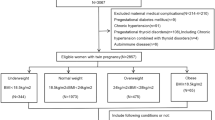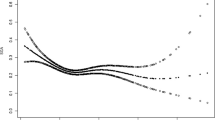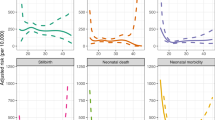Abstract
Objective:
To determine whether inadequate gestational weight gain in the second trimester in twin pregnancies is associated with an increased risk of preterm birth (PTB) at <32 weeks.
Study Design:
Retrospective cohort study including 489 twin pregnancies delivered between 2001 and 2013. Rates of weight gain at different gestational ages were compared with Institute of Medicine guidelines.
Result:
An inadequate rate of weight gain at <20 weeks was not associated with PTB. Patients with inadequate rates of weight gain at 20 to 28 weeks had a higher risk of PTB at <32 weeks (37.6%) compared to those with adequate weight gain (15.2%) (P<0.001). In multivariate analysis, women with inadequate weight gain at 20 to 28 weeks were 2.8 times more likely to deliver at <32 weeks (95% confidence interval 1.65 to 4.81).
Conclusion:
Inadequate gestational weight gain at 20 to 28 weeks in twin pregnancies was the strongest predictor of PTB at <32 weeks. This represents an optimal time for interventions to improve weight gain and potentially decrease rates of PTB.
This is a preview of subscription content, access via your institution
Access options
Subscribe to this journal
Receive 12 print issues and online access
$259.00 per year
only $21.58 per issue
Buy this article
- Purchase on Springer Link
- Instant access to full article PDF
Prices may be subject to local taxes which are calculated during checkout
Similar content being viewed by others
References
Luke B, Keith LG . The contribution of singletons, twins and triplets to low birth weight, infant mortality and handicap in the United States. J Reprod Med 1992; 37 (8): 661–666.
Dietz PM, Callaghan WM, Cogswell ME, Morrow B, Ferre C, Schieve LA . Combined effects of prepregnancy body mass index and weight gain during pregnancy on the risk of preterm delivery. Epidemiology 2006; 17 (2): 170–177.
Fox NS, Rebarber A, Roman AS, Klauser CK, Peress D, Saltzman DH . Weight gain in twin pregnancies and adverse outcomes: examining the 2009 Institute of Medicine guidelines. Obstet Gynecol 2010; 116 (1): 100–106.
González-Quintero VH, Kathiresan AS, Tudela FJ, Rhea D, Desch C, Istwan N . The association of gestational weight gain per institute of medicine guidelines and prepregnancy body mass index on outcomes of twin pregnancies. Am J Perinatol 2012; 29 (6): 435–440.
Schieve LA, Cogswell ME, Scanlon KS, Perry G, Ferre C, Blackmore-Prince C et al. Prepregnancy body mass index and pregnancy weight gain: associations with preterm delivery. The NMIHS Collaborative Study Group. Obstet Gynecol 2000; 96 (2): 194–200.
Institute of Medicine (US) and National Research Council (US) Committee to Reexamine IOM Pregnancy Weight Guidelines Rasmussen KM, Yaktine AL editors. Weight Gain During Pregnancy: Reexamining the Guidelines. National Academies Press (US): Washington (DC), 2009.
Abrams B, Carmichael S, Selvin S . Factors associated with the pattern of maternal weight gain during pregnancy. Obstet Gynecol 1995; 86 (2): 170–176.
American College of Obstetricians and Gynecologists. ACOG Committee opinion no. 548: weight gain during pregnancy. Obstet Gynecol 2013; 121 (1): 210–212.
Pipe NG, Smith T, Halliday D, Edmonds CJ, Williams C, Coltart TM . Changes in fat, fat-free mass and body water in human normal pregnancy. Br J Obstet Gynaecol 1979; 86 (12): 929–940.
Committee on Practice Bulletins - Obstetrics, The American College of Obstetricians and Gynecologists. Practice bulletin no. 130: prediction and prevention of preterm birth. Obstet Gynecol 2012; 120 (4): 964–973.
Gardner B, Wardle J, Poston L, Croker H . Changing diet and physical activity to reduce gestational weight gain: a meta-analysis. Obes Rev 2011; 12 (7): e602–e620.
Streuling I, Beyerlein A, von Kries R . Can gestational weight gain be modified by increasing physical activity and diet counseling? A meta-analysis of interventional trials. Am J Clin Nutr 2010; 92 (4): 678–687.
Luke B, Brown MB, Misiunas R, Anderson E, Nugent C, van de Ven C, Burpee B, Gogliotti S . Specialized prenatal care and maternal and infant outcomes in twin pregnancy. Am J Obstet Gynecol 2003; 189 (4): 934–938.
Blomberg M . Maternal and neonatal outcomes among obese women with weight gain below the new Institute of Medicine recommendations. Obstet Gynecol 2011; 117 (5): 1065–1070.
Mamun AA, Kinarivala M, O'Callaghan MJ, Williams GM, Najman JM, Callaway LK . Associations of excess weight gain during pregnancy with long-term maternal overweight and obesity: evidence from 21 y postpartum follow-up. Am J Clin Nutr 2010; 91 (5): 1336–1341.
Rooney BL, Schauberger CW, Mathiason MA . Impact of perinatal weight change on long-term obesity and obesity-related illnesses. Obstet Gynecol 2005; 106 (6): 1349–1356.
Bloom SL, Yost NP, McIntire DD, Leveno KJ . Recurrence of preterm birth in singleton and twin pregnancies. Obstet Gynecol 2001; 98 (3): 379–385.
Esplin MS, O'Brien E, Fraser A, Kerber RA, Clark E, Simonsen SE et al. Estimating recurrence of spontaneous preterm delivery. Obstet Gynecol 2008; 112 (3): 516–523.
Kyrklund-Blomberg NB, Cnattingius S . Preterm birth and maternal smoking: risks related to gestational age and onset of delivery. Am J Obstet Gynecol 1998; 179 (4): 1051–1055.
Nicholson W, Croughan-Minihane M, Posner S, Washington AE, Kilpatrick SK . Preterm delivery in patients admitted with preterm labor: a prediction study. J Matern Fetal Med 2001; 10 (2): 102–106.
Patra J, Bakker R, Irving H, Jaddoe VW, Malini S, Rehm J . Dose-response relationship between alcohol consumption before and during pregnancy and the risks of low birthweight, preterm birth and small for gestational age (SGA)-a systematic review and meta-analyses. BJOG 2011; 118 (12): 1411–1421.
Ogden Cynthia L, Carroll Margaret D, Kit Brian K, Flegal Katherine M . Prevalence of childhood and adult obesity in the United States, 2011-2012. JAMA 2014; 311 (8): 806–814.
McDonald SD, Pullenayegum E, Taylor VH, Lutsiv O, Bracken K, Good C et al. Despite 2009 guidelines, few women report being counseled correctly about weight gain during pregnancy. Am J Obstet Gynecol 2011; 205 (4): 333 e1-6.
Author information
Authors and Affiliations
Corresponding author
Ethics declarations
Competing interests
The authors declare no conflict of interest.
Rights and permissions
About this article
Cite this article
Pettit, K., Lacoursiere, D., Schrimmer, D. et al. The association of inadequate mid-pregnancy weight gain and preterm birth in twin pregnancies. J Perinatol 35, 85–89 (2015). https://doi.org/10.1038/jp.2014.160
Received:
Revised:
Accepted:
Published:
Issue Date:
DOI: https://doi.org/10.1038/jp.2014.160
This article is cited by
-
Comparison of DNA methylation profiles associated with spontaneous preterm birth in placenta and cord blood
BMC Medical Genomics (2019)
-
The effect of gestational weight gain on perinatal outcomes among Chinese twin gestations based on Institute of Medicine guidelines
BMC Pregnancy and Childbirth (2019)
-
Examining the provisional guidelines for weight gain in twin pregnancies: a retrospective cohort study
BMC Pregnancy and Childbirth (2017)



